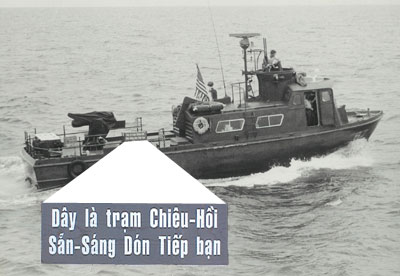|
This is a subject that requires an entire book to explore in
depth. The Chieu Hoi (Open Arms) program was the biggest and most expensive psychological
operation (PSYOP) campaign of the 10-year Vietnam War. It is impossible to cover every
aspect of such an all-encompassing program. We will just look at some general concepts and
illustrate leaflets that show the many themes of the operation.
The history the phrase "Chieu Hoi" is not widely known. The Headquarters,
USMAC-V Office of the Psychological Operations Directorate Newsletter dated 11
December 1967 says, "In the 14th century, King Le Loi led the Vietnamese people in
their struggle against the Minh dynasty of China. Amnesty was offered to certain civil
prisoners if they would fight for King Le Loi against the Minh. The amnesty offer included
a phrase similar to "Chieu Hoi". The phrase "Chieu Hoi" is a
combination of two verbs "to welcome" and "to return." Celebration of
Le Loi's victory is on the 22nd day of the 8th lunar month (Gregorian calendar equivalent
to late September)."
Midshipman Jason Thomas Chaput of Annapolis adds detail in a 2000 thesis. "Though
almost entirely carried out by the Government of South Vietnam, for its duration, the
Chieu Hoi Program was clearly a foreign-inspired endeavor. Begun in 1963, the program was
primarily the result of the efforts of two foreigners, Sir Robert Thomas and Rufus
Phillips." Thomas headed the British Advisory Mission to Vietnam. [Author’s
note: Many years ago when we studied and taught the lessons of the successful military
resistance against Communist-inspired rebellions, the three examples referenced in the
literature were Malaya, the Philippine Islands, and Greece. Each of these guerrilla
defeats was caused by a different circumstance. Readers who are interested should study
these government’s victories. Sir Robert Thomas is usually credited with bringing the
Chieu Hoi concept to President Ngo Dinh Diem. Thomas had taken part in the fight against the
Malayan insurrectionists and was considered an expert on the subject by Diem.]
Curiously, the Americans also took credit for the origin of the Chieu
Hoi program. A government booklet entitled Chieu Hoi and National Reconciliation
says, "The Chieu Hoi program originated in the minds of the Agency for International
Development (AID) personnel in 1962 who were familiar with the experience of Philippines
President Magasaysay and the Armed Forces Economic Corps (EDCOR) program against the HUKs
in the early 1950s. They sold the idea to the GVN with support from other members of the
country team, and the GVN officially launched the program in 1963." Apparently, when
an idea is successful, everyone wants the credit.
Chaput goes on, "Phillips, the head of the Rural Affairs Office for the U.S.
Operations Mission (USOM), worked in conjunction with Vietnamese Colonel Hoang Van Lac to
sell the idea to Diem's brother. On April 17, 1963, Diem issued a proclamation, which
simply called upon the insurgents to stop fighting and rally under the flag of the
Government…responsibility and direction for the program fell under the jurisdiction
of the Commissariat in the President's office. On the U.S. side, direct responsibility for
funding and advising lay in the hands of the Rural Affairs Office…American input and
assistance, according to the program's original design, was to be limited to conducting
training programs and providing funds and materials to construct the Chieu Hoi Centers
where the defectors would rally.
Jerald W. Berry adds more in his book Psychological Warfare leaflets of the Vietnam
War,"self-published and sold on CD, 2001:The original name of the Chieu
Hoi Program was Phong-Trao Chieu-Tap Khang-Chieu Lam Dong, or The Movement to Regroup
Misled Members of the Resistance. The Vietnamese eventually abbreviated the name to Chieu
Hoi. The Vietnamese word 'Chieu' means' to appeal", and the word 'Hoi' means 'to
return". These two words used together translates into 'a call to return' to the
family of South Vietnam."
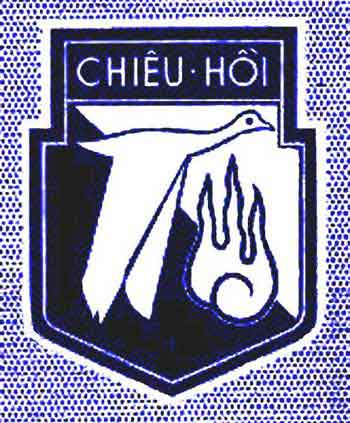
The Chieu Hoi Symbol
The Chieu Hoi symbol is in the form of a shield and depicts a stylized long-winged
white bird at the left flying toward a flame at the right. The words "CHIEU HOI"
are above the image.
The theme song of Chieu Hoi started with the lyrics, "tung ca'nh chim ti`m ve^`
to^ a^´m" which translates to, "Bird, fly home to your warm nest." The
dove was used as an invitation to the VC to come back home with loved ones. The Vietnamese
believed that the birds always returned to their nest! Hence, the symbol of the white dove
(a universal symbol of peace) flying toward the fire, which to the Vietnamese represents
the warmth of family, homecoming and reunion.
It has also been suggested that the flame could represent the difficulty and hardship
that the Viet Cong member had to endure during his time in the south and especially during
his escape. By acknowledging the danger, the GVN and the Americans implied that they were
sympathetic and would respect the returnee. An understanding of the symbols on the Chieu
Hoi symbol might help the Viet Cong member to be more confident in the good treatment he
would receive when going Hoi Chanh.
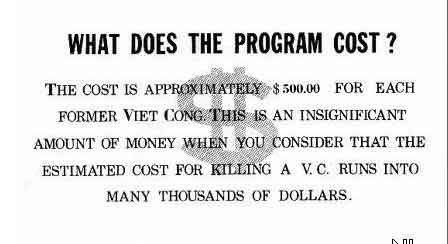
1970 Estimate on Approximate Cost per rallier
The Chieu Hoi Program began in 1963. There was little American involvement, yet
the number of ralliers was over 11,000. Another 10,000 rallied in 1965 as the first
American ground troops began to flow into South Vietnam. As the ground war gained momentum
in 1966, Chieu Hoi brought in over 20,000 ralliers. Berry tells us, "American
officials had already realized that the Chieu Hoi Program had the most potential as an
effective pacification program and had the most favorable cost/benefit ratio of any other
existing pacification program. The average cost of processing, retraining, and resettling
a returnee was $14 in 1963. This cost rose to $250 in 1967, to $350 in 1969 and to $500 in
1970. Even the increased cost seemed minuscule to the United States, especially when
considering the military cost in lives and equipment to eliminate each one of these as
enemies.
The cost of getting a Viet Cong to rally was constantly argued in the
press. Elliot Harris, author of The un-American Weapon - Psychological Warfare, M.
W. Ladd Publishing Company, New York, 1957, says "The average cost expended to cause
one Viet Cong guerrilla to defect is $125, vs. the average cost expended to kill one Viet
Cong guerilla, $400,000."
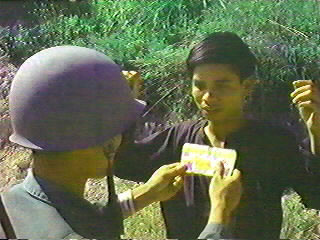
A Viet Cong Hoi Chanh
William F. Johnston gives some rather staggering dollar numbers in a 1968 article entitled
"Some thoughts on Psychological Operations." He says, "To date, the total
defections of Viet Cong returning under the program total 75,000. If we take this figure
in the commonly accepted ratio of ten government soldiers needed for each insurgent
guerilla, the program has saved the GVN-US a troop strength of over 750,000 soldiers. If
we do a little arithmetic from the dollar-saved angle, the total cost of the program,
using a cost-sited figure of $127 to bring in a Viet Cong defector, would be around nine
and a half million dollars. But looking at the cost to kill a Viet Cong, which is
estimated at $300,000 each, this number would have cost two and a quarter billion
dollars."
About the program, Berry says, "In 1967, the United States took complete control
of directing the Chieu Hoi Program and actively stepped up pacification efforts. Despite
the lack of trained personnel and language barriers, the program netted more than 27,000
returnees. There were hundreds of American advisors involved in administering the program
at this point in the Vietnam War."
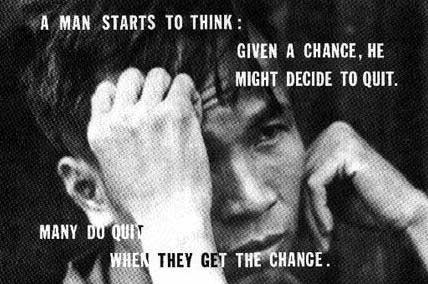
Page from Chieu Hoi - The Winning Ticket (1970)
By April 1975, the program had attracted more than 159,000 soldiers and members of the
Communist Party underground organizations to rally to the Republic of Vietnam (RVN). About
15,000 were from North Vietnam Army (NVA) regular units. The ralliers received vocational
training and got help in finding jobs. A large number enlisted in the Government of
Vietnam's Army (ARVN) and various paramilitary units. About 700 served American combat
platoons as Kit Carson Scouts. Many of the ralliers contributed their skill and their
intelligence information as well as their blood to the just cause of the RVN. Thanks to
their contribution, the allied forces achieved numerous feats of arms, including
destruction of important targets in North Vietnam.
Berry’s numbers are even higher. He says, "By the end of American involvement
in the Vietnam War, over 194,000 former VC, NVA, and Communist sympathizers had rallied to
the GVN. These numbers alone should represent a measure of success for the Chieu Hoi
Program."
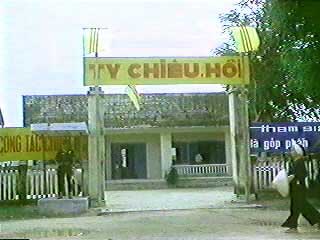
A Provincial Chieu Hoi Center
There were three types of Chieu Hoi Centers. They were National,
Regional, and Provincial. The National Chieu Hoi Center was located at Thi Nghe in Saigon
and was able to accept 4000 returnees a year (in three month increments).
The Regional Centers were originally in Danang, Pleiku, Bien Hoa, and Can Tho. They
could accommodate 2,400 returnees a year.
There was one provincial center in each of the 44 provinces in 1967. Some cities had
special centers and as a result, there were 47 provincial centers in all.
What was the official American concept of the program? Guideline to Chieu Hoi
Psychological Operations: The Chieu Hoi Inducement Program, prepared by the Field
Development Division of JUSPAO, April 1966 says, "The Chieu Hoi inducement program
consists of all activities designed to cause members of the Viet Cong and their supporters
to leave the Viet Cong and return to the side of the rightful and legitimate Government of
the Republic of Vietnam. The Chieu Hoi inducement program consists of: Psychological
operations addressed to Viet Cong military forces, Viet Cong civilian Infrastructure,
families of the Viet Cong and the population of Viet Cong-controlled areas.
The Chieu Hoi program was not universally admired among the Vietnamese
officials and military. The Command History - 1967 of the United States Military Assistant
Command in Vietnam says, "The GVN support of the Chieu Hoi Program lacked a 100
percent participation on the part of the GVN officials, for many believed that too much
was being done for the Hoi Chanhs. A characteristic remark was ‘They were the enemy
once. When they returned they were not sent to prison, but were even allowed to return to
their families.’ One American MACV officer said,"Many Province Chiefs are quite
simply against Chieu Hoi and will pay lip-service to national policy while dragging their
feet at the province level. Other Vietnamese point out the apparent difficulty in
maintaining an aggressive attitude in the GVN armed forces against the Viet Cong on one
hand, and a lenient police toward returnees on the other."

Ralliers were educated and trained in new skills.
What did the Viet Cong think of the Chieu Hoi program? A South Vietnam Liberation Army
document dated 20 December 1966 says:
|
The impact of increased enemy military operations and 'Chieu Hoi'
programs has, on the whole, resulted in lowering of morale of some ideologically backward
men, who often listen to enemy radio broadcasts, keep in their pockets enemy leaflets, and
wait to be issued weapons. This attitude on their part has generated an atmosphere of
doubt and mistrust among our military ranks.
|
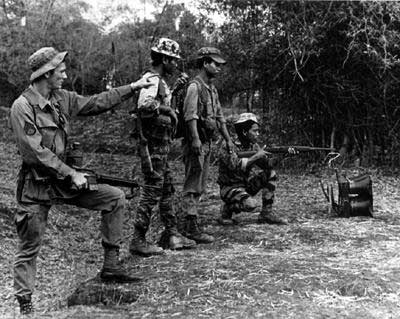
PSYOP Loudspeaker Team
Another captured Viet Cong document states:
|
At present, the enemy is using psychological warfare to attack us on the ideological plane.
He has scattered many leaflets from aircraft and has appealed to us through (loudspeaker)
broadcasts. The objective of this is to destroy our morale...
These efforts surely influence our troops. If we do not closely control cadre and soldier
thoughts, we shall face many difficulties. For this is a dangerous wicked scheme by the
enemy. It is related to the general war situation, all aimed at reducing the fighting
spirit of our forces and having a great influence on our struggle toward victory in
general...
Carefully indoctrinate troops, cadres and soldiers about the enemy's psychological warfare
schemes. Make clear to all people the fact of his corruption and that he pretends to be
very strong but cannot hide his failures...
Whenever the enemy uses psychological warfare, cadres should immediately hold
indoctrination sessions and closely manage the people's thoughts and actions...When
leaflets drop, all people, even the cadres and soldiers, should tear them up without
reading them. Only cadre chiefs (team chiefs) are authorized to read and then explain and
analyze the contents of the leaflets to the cadres and to soldiers in their units.
|
An article entitled "Viet Cong Documents on the War" published in Communist
Affairs, January-February 1968, quotes over two dozen documents where the Viet Cong
leadership warns of the Chieu Hoi threat. One of the most interesting finds the commissars
offering a carrot, a stick, or a pat on the back:
|
In case we discover a cadre or fighter who induces some other people to desert
our ranks, we are to throughly study the case to see whether that cadre is someone sent by
the enemy or just a person who could no longer endure hardships and has resorted to such
wrong means.
If the man happens to be a real enemy, then we must deal with him in a proper manner.
If he happens to belong to the second case, then we must reeducate and reform him right in
the unit.
In case some cadres and fighters receive appeals from their families to return and
inform us about such moves, we are to promote their revolutionary spirit and comfort them.
We must also make public such a revolutionary spirit and have it studied by other people.
Concurrently, we are to consolidate their thought and strive to prevent them being shaken
by other appeals that will be launched by their families at other times. Finally, we are
to motivate people to write letters to build revolutionary concepts for their families or
inform regional authorities to take care of that work.
|
The Chieu Hoi Program in Vietnam, by Ho Van Cham, The Vietnam Council of
Foreign Relations, Saigon, Republic of Vietnam, November 8, 1970, reports an interesting
example of one of the successes of the Chieu Hoi program:

Former Viet Cong militia who rallied near Tam Ky
|
Quang tru province was the scene of one of the most spectacular mass defections
in Chieu Hoi history. The commanders of two Viet Cong units garrisoning villages in a
coastal wasteland district near Tam ky, a district that had remained outside government
control since 1946, came over to the Republic's side with all of their militia troops --
221 veteran, hard core communists in December 1969. Those troops elected to Chieu Hoi and
began fighting communists.
It all started in with Ngo Thoi, a disillusioned VC Officer,whose Viet Cong rank was
equivalent to captain. Thoi had a brother who was a sergeant in the government forces at
Tam Ky. Through him, Thoi made a proposal to the province chief, Colonel Hoang Dinh Tho.
He would defect with his entire militia unit if the province chief re-armed the men with
modern weapons, kept them together as a government fighting unit under their own leaders,
waived the orientation period, permitted them to stay with their families, and brought
prompt material assistance to their war-ravaged village. Colonel Tho accepted the
conditions, whereupon another Viet Cong commander from the same district, 27 year old Tran
Quyen, petitioned for a similar arrangement. Again Colonel Tho agreed. As Thoi and Quyen
assembled their men for the mass defection ceremony, the news flashed through the fishing
villages of the district and guerillas from local squads attached themselves to the force
of ralliers
Colonel Tho selected ten volunteers from the new Hoi Chanh group and made them scouts
for the province's Regional Forces Reconnaissance Company, which began combing the
district for boobytraps, arms caches, bunkers complexes and for other potential Hoi Chanh.
Within three weeks more than 200 had rallied to the government's side. Within a month the
reconnaissance company, placed into ambush position by their new scouts, intercepted a
main force VC Unit. The VC regulars lost 78 dead to the Regional Forces Company and their
Hoi Chanh scouts.
As the rest of the Hoi Chanh, newly equipped with combat boots and M-16 rifles, went on
patrol in the district, Colonel Tho lived up to his side of the bargain. Relief supplies
were shipped to the hamlets. In Quyen's village, arrival of a shipment of lumber and
roofing material from provincial headquarters was the signal for the start of a community
self-help program, and soon the grass huts were replaced by sturdy dwellings. A tent
market was airlifted from Tam Ky, bringing all the small items from the outside world that
the villagers had not seen for years -- manufactured soap, cigarettes, finished textiles,
shoes. To obtain money with which to buy these items, the Hoi Chanh stepped up their
jungle combing activities and uncovered many more Viet Cong arms caches. The reward money
for the weapons took the villagers off the barter economy that they had known for two
dozen years.
Colonel Tho's gamble paid off and the communist grip on the district was shattered.
Said Lietenant Colonel M.G. Stafford, senior U.S. Observer in Quang Tin province:
"It's going to be very hard for the Viet Cong main force units or for the North
Vietnamese Army Units to do anything in this district from now on. These guys here, these
new Hoi Chanh, are some of the finest troops I've seen. They know all the trails and all
the tricks that the communist units in this area have used.
Why, after nearly 25 years under communist rule, had these Quang Tin Villagers welcomed
government control, and why had professional Commanders like Thoi and Quyen defected with
all their troops? The fact that Thoi could talk over the situation with his brother, and
the fact that Colonel Tho had the wisdom to bend a little of the conventional Chieu Hoi
procedures were factors. But Thoi gives another reason:
|
|
The main force communist units in our area had left us on our own, saying that
there was too much military pressure from the government for them to stay. They promised
to return soon but advised us in the meantime to leave our women and children and hide
whenever government troops came near our village. We could not accept this.
|
Quyen's main reason was more general:
|
I have lived on promises too long -- promises that the Viet Cong would win and end
the war soon. |
Quyen's reason -- disillusionment with the communist apparatus and its goals and
promises -- is given by a number of ralliers when they are interviewed at Chieu Hoi
Centers. They say they had witnessed too many broken promises to retain any confidence in
the good intentions of the communists. Sixty-five percent say they were drafted into
communist ranks, 35 percent volunteered. But about half say they did not know what they
were fighting for and merely obeyed orders. About half say that at first they believed
they were fighting for the betterment of the poor, for the welfare of the nation and for
the freedom from aggression and imperialism. Loss of these convictions, often coupled with
other motives, led them to rally to the government's side.
Naturally, there were some arguments about the
value of the program. Thomas L. Hughes, Department of State, Bureau of Intelligence and
Research, said in his Memorandum, Statistics on the War Effort in South Vietnam Show
Unfavorable Trends, 22 October 1963: In addition to the military defectors, some
13,700 persons "rallied" to the government from April through August 1963 under
a national surrender and amnesty campaign. This campaign, known as "Chieu Hoi,"
was officially inaugurated on April 19. The South Vietnamese government regards the bulk
of these as Viet Cong. United States officials, who do not screen these statistics,
believe the vast majority to be refugees and persons who, for one reason or another, have
left areas controlled or formerly controlled by the Viet Cong. Many of them, however, may
well have assisted the Viet Cong in some way voluntarily or under duress. The number of
"Chieu Hoi" returnees increased progressively from April 19 to June 1963, when a
high of about 3,200 was reached. By August, returnees dropped to a low of about
1,600."
The civilian "Bible" of Vietnam PSYOP is the Robert W. Chandler book War
of Ideas: The U.S. Propaganda Campaign in Vietnam, A Westview Special Study, Boulder,
CO, 1981. Chandler devotes an entire chapter to the Chieu Hoi program in this book.
Although we have drawn from many other official military and government documents for this
web page,much of our data follows Chandler’s general outline expressed in his summary:
|
The government's American-inspired and funded amnesty invitation, the
Chieu Hoi or "Open Arms" program...was adopted in 1963 as a magnanimous offer of
forgiveness and exoneration to those who had been temporarily seduced into following the
alien Communist path." He goes on, "The term 'surrender' was avoided; instead
the Viet Cong were implored to atone for their past sins by 'rallying' to the 'just cause'
of the Republic." Promises included, "good treatment, medical care, and
repatriation after the war. He continues, "Do not fear detention after your capture
or surrender. you will be comfortable and well cared for. Wounded prisoners receive the
best medical care.
|
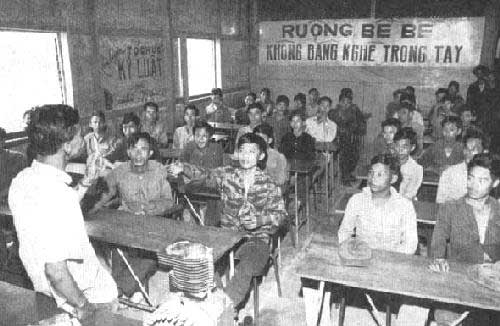
Chieu Hoi Ralliers at the Bien Hoa Chieu Hoi Center received training in
automotive repair to help them in their new lives
The American government spent the greatest amount of money and placed the greatest
emphasis on the Chieu Hoi program. In conjunction with the Republic of Vietnam they built
reception centers at various locations throughout the country. The ralliers (Hoi Chanh)
remained in the camp for forty-five to sixty days where they received indoctrination and
were then resettled.
In 1966 the Joint U.S. Public Affairs Office (JUSPAO) drew up a plan to work on five
conceived weaknesses of the enemy. They were:
1. Fear (of death, injury, American technology, lack of proper burial etc.)
2. Hardships (the terrible march south, jungle diseases, lack of medical supplies,
absence from family and loved ones, etc.).
3. Loss of faith in Communist victory (reports of Communist defeats, list of dead VC,
overwhelming might of RVN and American forces, the coalition massed against the VC, etc.).
4. Concern for family. (The wife and family at home unprotected without a man in the
house, the children growing up without a father's guidance, etc.).
5. Disillusionment. (You were duped by the Communists, the South Vietnamese do not
want to be liberated, you are fighting for your old enemy China, you are
killing your own kind, etc.).
Besides the five standard themes, there were four special campaigns.
1. Safe conduct passes dropped in the billions.
2. A reward campaign offering money for weapons,
information, individuals and units.
3. A Tet campaign waged each New Year when the soldier would naturally yearn to return
home.
4. Recruitment of the Hoi Chanh as part of the propaganda teams.
The Military Assistance Command, Vietnam (MACV) published a Directive 381-11-1 On 5
August 1968 entitled Military Intelligence Exploitation of Human Sources and Captured
Documents.
The document says, "Returnees are particularly fruitful sources of information
because, unlike prisoners of war, they have made a personal decision to reject their
former allegiance. The psychological barrier of "name, rank, service number, and date
and place of birth" does not exist. Interrogation, exploitation, detention, and
processing must take into full account the significantly different status of the
returnees.
RVN authorities require that the returnee be delivered to a Chieu Hoi agency within 48
hours of the original contact with friendly elements. During this period he may be
interrogated for perishable information of immediate tactical value. If, for some reason,
he cannot be delivered to the local Chieu Hoi agency within this length of time, immediate
notification must be given the Province Chieu Hoi officials of the arrival of the
returnee. Interrogation and exploitation should be accomplished as expeditiously as
possible.
Returnees reporting to RVN agencies or directly to the Province Chieu Hoi Center will
be available at the Chieu Hoi Center for interrogation upon request by the local senior US
intelligence officer to local Chieu Hoi officials. GVN Chieu Hoi regulations require that
interrogations be conducted in the Chieu Hoi Centers which are located at Province,
Region, and National levels. The purpose of these regulations is to prevent hostile
interrogation or mistreatment of Hoi Chanh. In special cases, however, returnees may be
removed from the Center provided Chieu Hoi officials are aware and are in agreement with
proposed action. The local senior US intelligence officer will establish continuing
liaison with ARVN and GVN Chieu Hoi officials to insure that returnees who report directly
to the Province Chieu Hoi Center are properly interrogated and reported.
Returnees may be asked to volunteer to assist military operations as guides or
informants; however, such request must be approved by the local Chieu Hoi officials. Units
using returnees in such operations will insure that the individuals are adequately
protected, fed, housed, and returned to the Chieu Hoi Center immediately upon completion
of the operation. A report will be furnished the local Chieu Hoi officials of the results
of the operation in order to properly reward the returnee for his information.
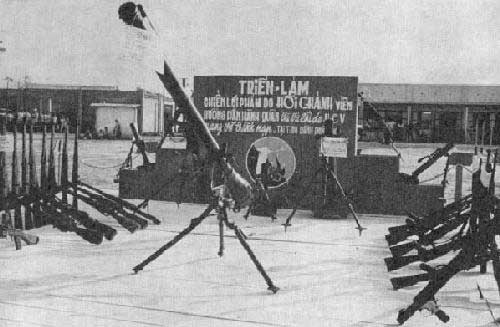
Some of the weapons turned over by ralliers were displayed at the Binh
Duong Chieu Hoi Center. 3
Receipt for confiscated weapons, monies, and documents will be issued to the returnee
by the receiving unit or agency prior to transfer of the returnee to the Chieu Hoi Center.
Returnees should not be evacuated as prisoners of war, but should be delivered to the
nearest Chieu Hoi official or office (there is an office in each district). If for some
reason returnees must be evacuated through intelligence channels to higher or adjacent
headquarters, the CMIC, or a Corps CIC, the local Chieu Hoi officials must be
notified."
PSYOPS POLICY No. 59, dated 20 February 1968 contains a psychological
operations policy and guidance. It was prepared by JUSPAO, the military agency that
directed U.S. propaganda efforts from Saigon in accordance with US mission directives, and
was to be implemented as pertinent by all U.S. Elements in Vietnam. The title is "The
North Vietnam Army (NVA) Soldier in South Vietnam as a PSYOP Target." Besides
guidance, the policy paper mentions a number of standard leaflets available for immediate
reprint should the need arise. SP-1415 "Who Is Your Enemy?," SP-2263 "NVA
Poem," SP-2266 "Good Treatment for NVA POWs," SP 2267 "To Soldiers of
the NVA" (a Tet greeting), SP-2273 "Soldiers of the NVN People’s Army"
(Tet Greeting), SP-2277 "The RVN Invites You," and SP-2236 "NVA POWs Live
Peacefully."
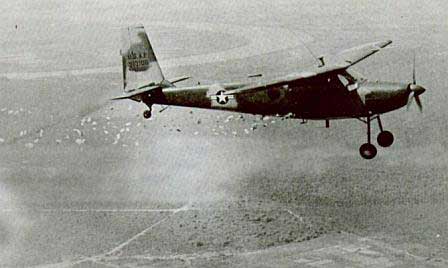 U-10 aircraft disbursing leaflets
U-10 aircraft disbursing leaflets
It is impossible to determine how many Chieu Hoi leaflets were produced during the
length of the war. The Leaflet Catalog, 7th PSYOP Battalion, Danang, 1969, lists no less
than 65 leaflets in the special category "Chieu Hoi." The first is 7-757-68,
"Soldier of North Vietnam," the last is 7-528-69, "The Nguyen Trai
Campaign." The latter was a campaign to psychologically attack enemy cadre and
soldiers to cause them to rally. These 65 leaflets are just from a single battalion in a
bit more than one year of the war.
The catalog also mentions various mixes of Chieu Hoi leaflets that were designed to be
dropped together. For instance, mix 4 consists of 7-565-68 "With aching Heart,"
7-690-68 "Chieu Hoi Poems," and 7-757-68 "Chieu Hoi is for VC/NVA."
Mix 12 consists of JUSPAO leaflets SP3210 "I can't stop weeping," and SP3211
"Rallying helps you return to your friends."
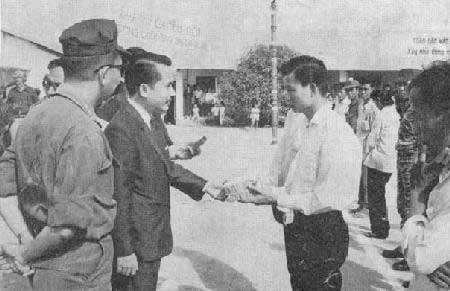
A former VC guerilla receives a cash award after he rallied to the GVN
side then led allied troops to a large cache of communist weapons.
The reader must remember that there were also various leaflets offering rewards for
weapons and information, monetary offers, safe conduct passes, etc., all of which were
part of the program but not specifically listed under "Chieu Hoi."
The catalog mentions five Chieu Hoi themes under the heading "Instructions for use
of objectives/ appeals indicators." The instructions are, "The Chieu Hoi
campaign: The PSYOP objective is to cause the enemy to rally. This is done essentially,
with five types of themes or appeals:
1. Rallier exploitation (exploitation of Hoi Chanh).t>
2. Rally appeals (inducements to rally so as to relieve a condition; i.e. fighting for
the wrong cause).
3. Third party inducement (an appeal to a third party to convince a member in the enemy
ranks to rally).
4. Advertisement (an advertisement of the benefits a Hoi Chanh derives from rallying).
5. Instructions (how to rally).
Were there additional items produced and distributed besides themed leaflets?
Absolutely. We have already stated that this was the biggest and costliest PSYOP program
during the Vietnam War. There were hundreds, and perhaps thousands of other objects used
to convince the enemy to rally.
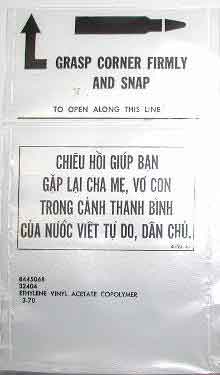
Chieu Hoi - M-16 Magazine Packages
The climate of Vietnam was hot and wet. M16 ammunition was sometimes packed in a
plastic waterproof bag that was discarded after use. A Chieu Hoi message was placed on the
bag so that it could be left along the trail for the VC to find and read. The text is
"Returning [Chieu Hoi] will help you again see your parents and family in a peaceful
and democratic [South] Vietnam."
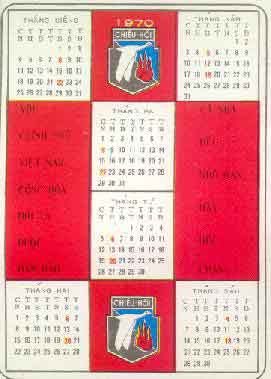 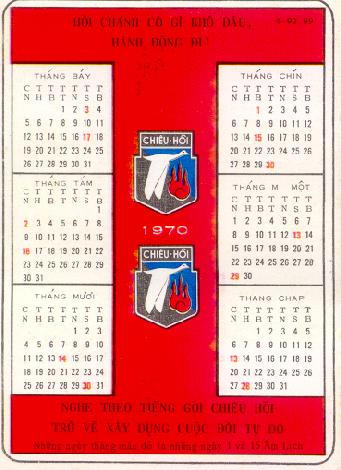
1970 Chieu Hoi Pocket Calendar
Small pocket calendars and large wall calendars were given to the military and the
public. They bore the Chieu Hoi emblem and/or a message.
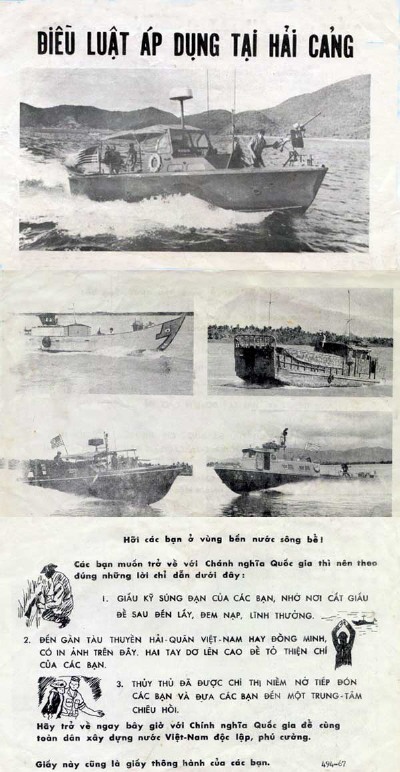
Navy Boats Chieu Hoi Poster
Hundreds of different posters were printed and put up on walls and poles wherever the
people were likely to congregate. Even the Navy got into the act. Posters were used in the
Delta to induce Viet Cong to give themselves up. The United States Navy and the Vietnamese
Navy used Patrol Boats, River (PBR), Yabuta junks, River Assault Group (RAG) boats, and
Patrol Crafts, Fast (PCF) "swift boats" for missions where they played Chieu Hoi
tapes late into the night. Posters were produced showing the various vessels and reminding
the Viet Cong:
"Rules for the Costal and Water Port Areas.
To those who live in the Delta or Costal Areas:
If you want to return to the Just Cause of the Nation, please follow the following
instructions:
Hide your weapons, remember where you hide you weapon so you can retrieve it later for
rewards.
Approach South Vietnamese or Allied ships (pictures attached herewith), raise you hands
high to show your good will.
Our sailors are instructed to welcome you and to take you to a Chieu Hoi Center.
Please Return to The Just Cause of the Nation so we can build a prosperous nation
together.
This poster is a passport for your safe passage."
The vessels often had signs on the port and starboard railings and on the fantail which
said,
"
Every vessel of the Navy of Vietnam and the United States is a Chieu Hoi rallying
point for those friendly Viet Cong who want to return to the true government
"
A number of slogan cards were developed. These long cards were used by both
sides during the war. I have seen numerous pieces of paper with a pro-VC message on them.
Often the VC would take a regular piece of writing paper and prepare long streamers about
8 x 2 inches with anti-Government text. JUSPAO prepared a series of 20 x 5 inch slogan
cards, coded 1369 in August of 1966. There were seven different slogans printed, one to
each card. They are:
"1. Taking part in Chieu Hoi activities is an act of patriotism.
2. Chieu Hoi means building families and national brotherhood.
3. Chieu Hoi is the means by which VC cadres liberate themselves.
4. All the people take part in the Chieu Hoi activities.
5. Chieu Hoi is the shortest way leading to peace.
6. The Chieu Hoi policy is humanitarian.
7. If Chieu Hoi activities are strong, the VC cadres are demoralized."
There were also a number of small booklets published. One is coded 2078 and entitled
"The Chieu Hoi Story." Is is a three-color production and presents in cartoon
style the experiences and thoughts of a Hoi Chanh on the events which led to his decision
to rally. A second booklet is coded 2169 and entitled "Diary of a Returnee." It
is a 20-page booklet with 12 photographs describing the experiences of a Viet Cong soldier
from the time of his disillusionment to his return. It also lists Chieu Hoi benefits,
weapons rewards, and a photograph of the standard flag safe conduct pass.
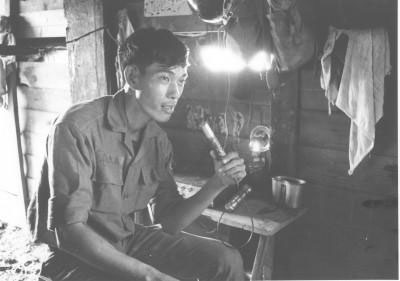
Recording PSYOP Tape
There were a number of short audio tapes available for use against the Viet Cong and
NVA. In the National Catalog of PSYOP Material, JUSPAO, 1969, over 161 such tapes
are listed. Many of them are Chieu Hoi. One 38-second tape, number 7, is entitled
"Your choice, return to the Government of Vietnam or die." A male voice says:
"Do you want to get out of this living Hell? Do you want to live instead of dying?
If you want to live, then answer the call to Chieu Hoi. You have just two choices - death
or Chieu Hoi. You have just two choices - death or Chieu Hoi. Death or Chieu Hoi."
A second 47-second tape, number 26A, also features a male speaker. It starts with a
bugle call:
"Attention weary soldiers of North Vietnam! We know the hard times you face. Not
enough food; not enough medicine; your leaders have misled you; they are taking you down
the road to sure death. You see now they have not told you the truth. Do not die far from
home because of their lies. Return to the open arms of the Government of Vietnam. The
choice is up to you. Death...or come to the Open Arms of the Government of Vietnam! Death
of Chieu Hoi."
The message ends with a second bugle call.
A third 60-second loudspeaker tape fatures the sounds of women and children crying for
the first 20 seconds. Then an exchange between two voices is heard:
Announcer # 1: "Oh why is there such mournful crying"
Announcer # 2: "these are the sounds of sorrow coming from the homes you left, the
heart-broken cry of a young wife who has lost her husband – the sad cry of a mother
whose son will not return – the pitiful cry of a little child whose father has been
killed – cruelly robbed of life in the so called "war of liberation" –
the very war in which you now participate."
Announcer # 1: "It is also the sad, sad cry of families whose sons have died so
senselessly for communism."
Announcer # 2: "Why don’t you return at once to rejoin your family? They are
waiting for you. A child’s laugh is such a dear sweet sound. But the child’s cry
is such a sad and mournful sound. Isn’t it?"
The last 20 seconds of the tape is a repeat of the sounds of women and children crying.
An American inspiration was the use of paper bags printed with Chieu Hoi messages. The
concept was a good one. Shoppers would walk down the street with groceries that advertised
the program. It seems not to have worked. The Vietnamese did not normally use paper bags,
so in many case they cut the bags up and wrapped their purchases inside the paper. At any
rate, a number of such bags were prepared with printed messages. One was coded 2619,
printed in three colors and depicts a husband, wife and child along with a Chieu Hoi
symbol. The text is, "Chieu Hoi. We miss you at every evening meal: your mother, your
child and I am waiting for you. Return to the Just Cause and be reunited with your
family."
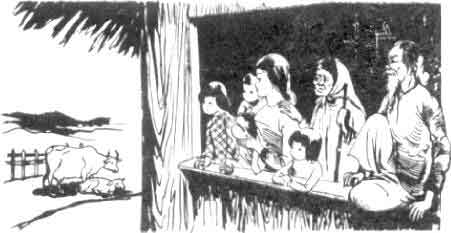
2620 Image of Vietnamese Familylooking out from their home
Besides paper bags JUSPAO also produced plastic bags. One pictured the Chieu Hoi symbol
and was printed in three colors. It was coded 2274 and entitled "Chieu Hoi bag."
Another plastic bag was coded 2620 and depicted a Vietnamese family looking out from their
home, with a Chieu Hoi symbol below them. The same vignette was used on leaflet 927A
("Compatriots, come home"). The text on the bag is, "Chieu Hoi. Friends
with the Viet Cong! Return to your family! They miss and need you."
Curiously, in the case of the paper and plastic bags, JUSPAO did not provide the items
freely. In both cases there is a note, "This is a contractor produced item. The funds
to have these bags produced must be provided by the requester." Perhaps it was
because they were considered commercial items.
Was the program successful? It is hard to say. Berry says, "The Chieu Hoi Program
was not very successful in influencing the hardcore Viet Cong at the higher levels of
command, or the dedicated North Vietnamese soldier. Only 1% of the total ralliers were NVA
military personnel. The highest-ranking Viet Cong to rally was LTC Le Xuan Chuyen. He had
been Deputy Chief of the 5th Viet Cong Division and later became director of the National
Chieu Hoi Center in Saigon. His story is a testament to the ultimate success of the Chieu
Hoi Program in South Vietnam. See Informative Leaflet 102, pages 38-39, for further
information on Lt. Col. Chuyen.
The typical Chieu Hoi returnee was from 15 to 25 years of age, had little or no education,
and had been a farmer or hired laborer before becoming a Viet Cong guerilla. Most
defectors rallied after being with the Viet Cong for less than a year. These returnees
were persuaded to surrender to the GVN by various propaganda leaflets generated by the
Chieu Hoi Program. Generally, VC morale was low because many of their recruits had been
pressed into service."
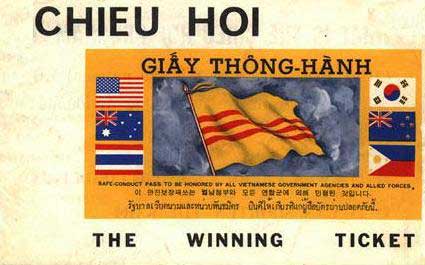
MACV Information Pamphlet on the Chieu Hoi program
A number of official military publications were prepared and distributed to the troops.
In both 1968 and 1970 small booklets entitled Chieu Hoi – The Winning Ticket
were published as an MACV Command Information Pamphlet. The pamphlet shows the 7-flag safe
conduct pass on the cover. The inner pages contain photos and text: "WHAT IS THE
CHIEU HOI PROGRAM? Chieu Hoi (Open Arms) is the national V.C. defector program. It pays
big dividends: It weakens the NVA/VC, it saves American lives, and it can shorten the war.
The Viet Cong know what they want. They give their men hard training and effective
indoctrination. The result – a dangerous enemy. But, the heat of the battle reveals
many weaknesses. The VC soldier soon finds out his cadre lied. He finds – he is
outgunned and outclassed; fighting for a phony cause – a lost cause. A man starts to
think: given a chance, he might decide to quit. Many do quit when they get the
chance."
The July, 1968 pamphlet gives the current count, "27,178 rallied to the government
in 1967. Of these, 17,671 were armed military Viet Cong/NVA. That is the same as two enemy
divisions. If we had been forced to eliminate those 17,671 on the battlefield, it would
have cost us and our allies about 5000 dead. Under Chieu Hoi we got those 17,671 over to
our side without taking casualties." In the March 1970 pamphlet the numbers rise,
"45,259 rallied to the government in 1967 and 1968. Of these, 29,276 were armed
military Viet Cong/NVA. That is the same as 95 enemy infantry battalions. If we had been
forced to eliminate those 29,276 on the battlefield, it would have cost us and our allies
about 6000 dead. For 1969 over 47,000 had rallied. The Chieu Hoi program brought those
ralliers over to our side without taking casualties."
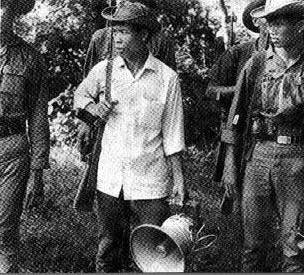
Chieu Hoi Propaganda Team Member
Both booklets go on, "When he comes over, he provide valuable information about:
enemy units, caches of weapons, ammunition, caches of food. He brings in or locates
weapons which otherwise would be used against you. Many serve as ‘Kit Carson’
scouts. They help you locate enemy mines, booby traps, and serve as guides for your unit.
Many former V.C. join armed propaganda teams, which talk other V.C. into rallying.
Finally, the former V.C. goes back to farming or some other occupation. What does the
program Cost? The cost is approximately $369.00 ($500 by 1970) for each former enemy Viet
Cong. This is insignificant when you consider that the estimated cost for killing a V.C.
runs into many thousands of dollars. How can you help? Let all the would be defectors (Hoi
Chanh) come in safely. Give voluntary defectors Chieu Hoi (not POW) treatment. Segregate
Chieu Hoi from POWs. Treat the returnee with respect. Give him a receipt for all weapons
that he brings in. Deliver him safely to the unit intelligence officer for prompt
debriefing and then promptly to the Government of Vietnam Chieu Hoi service at the nearest
district or province headquarters."
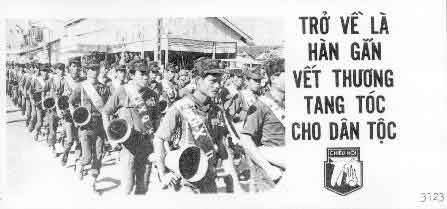
Leaflet 3123
On the subject of armed propaganda teams (APTs), JUSPAO leaflet 3123 depicts an entire
marching company of Vietnamese APTs, each with a loudspeaker under his right arm. To the
right of the photograph is a Chieu Hoi symbol and the text, " Return to alleviate the
suffering of the people." The back is all text, " The Chieu Hoi Cadres of Long
An Province. Deeply encouraged by the success of the Chieu Hoi program, the armed
propaganda teams of long An welcomes the prime Minister and Vietnamese government
officials to long An. The even was the opening ceremony of the ‘Spring for the
fatherland’ campaign. The aim of the Chieu hoi program is to urge those still on the
other side to return to their families and alleviate the sorrows of separation."
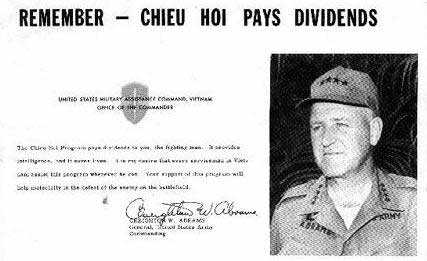
General Abrams
The final page in both pamphlets depicts a different photograph of General Abrams but
the same text, "Remember – Chieu Hoi pays dividends. The Chieu Hoi program pays
dividends to you, the fighting man. It provides intelligence and it save lives. It is my
desire that every serviceman in Vietnam assist this program whenever he can. You support
of this program will help materially in the defeat of the enemy on the battlefield.
(Signed) Creighton W. Abrams, General, United States Army, Commanding." The final
page shows a small aircraft dropping Chieu Hoi leaflets over the enemy.
There is another earlier and longer version of a similar pamphlet entitled Chieu
Hoi – A Winning Program. Some of the pertinent quotes from this version are,
"WHAT IS CHIEU HOI? Chieu Hoi is a program that appeals to military and civilian Viet
Cong and to North Vietnamese Army (NVA) soldiers to rally to the side of the rightful
government of the Republic of Vietnam. Translated, "Chieu Hoi" means "Open
Arms." Through Chieu Hoi, the government offers the hand of friendship and a new
beginning in life to any VC or NVA members. The program is directed specifically at
communist-infested areas. "Hoi Chanh" (pronounced Hoy Chun) is the name given
individual returnees, those who voluntarily return to government control after actively
supporting the VC. "Returnee" is the English term used. A group should be
addressed "Anh Chi Em Hoi Chanh," or "Our brothers and sisters who rally to
the just cause." Similarly, a man is addressed "Anh Hoi Chanh Nguyen Van X"
(Brother Nguyen Van X, Hoi Chang) and a woman "Chi Hoi Chang Nguyen Thi Y"
(Sister Nguyen Thi Y, Hoi Chanh).
Hoi Chanh often identify VC for government forces. In Da Nang one man
pointed out 20 VC to police in one day. In the 25th Division area another identified 16 VC
in one day. (The government determines the reliability of Hoi Chanh before using their
information, by careful interrogation and crosschecking of their stories with other
sources.) Hoi Chanh frequently volunteer to accompany troop units on sweeps through
villages. The benefits of using them on these operations are double. First, the Hoi Chanh
is familiar with the area and its people and can identify VC as well as clear loyal
villagers of suspicion. Second, the Hoi Chanh assists with population control by calming
the fears of the people. He knows the Americans, Australians or whatever the force is and
can tell the people that they have no cause for fear.
A rallier does not have to have a Safe Conduct Pass. In some cases, ralliers reported
never having seen the passes. They can bring in any leaflet, or come without a leaflet.
With or without a pass, a VC who wants to rally to the government often has a difficult
time doing so. He must escape and evade the VC, then make contact with friendly forces
without being shot by them. Rallying is even more difficult for the North Vietnamese
soldier. His life has been lived in a closely controlled society; he usually has no
information his Hanoi leaders do not want him to have. Not even radio broadcasts from the
south can reach him because only higher headquarters have radios. Once in the south, the
NVA soldier is usually stationed in deep jungle far from populated areas, in territory
unfamiliar to him. His actions are watched by the other members of his three-man
cell."
The booklet goes on to explain the Chieu Hoi organization. "The Vietnamese program
is supervised by the Ministry of Information and Chieu Hoi. On the U.S. side, three
agencies have Chieu Hoi responsibilities. USAID has executive responsibility for the Chieu
Hoi Program for the US Mission. JUSPAO furnishes Chieu Hoi advisers at national level to
assist GVN psychological warfare efforts, and JUSPAO field representatives help exploit
the program in the regions and provinces. MACV provides technical advice and assistance to
the Chieu Hoi program at all levels, particularly in PSYOP and in the area of exploiting
intelligence from Hoi Chanh.
Colonel Benjamin F. Findley, Jr. USAFR wrote a short review of selected parts of
the program entitled "US & Vietcong Psychological Operations in Vietnam,"
published in Psychological Operations Principles and Case Studies , Frank L.
Goldstein, Air University Press, 1996.
"Two special PSYOP targets were the Vietcong (VC) and the North Vietnamese Army
(NVA) soldiers in South Vietnam. Two Chieu Hoi operations carried out in the Delta during
1970 and 1971 proved that PSYOP and combat pressure working together could get results.
The operations were Operation Roundup in Kien Hoa Province and Project Falling
Leaves in Kien Giang Province. Operation Roundup produced hundreds of
enemy defectors, according to Colburn Lovett, a USIS foreign service information officer.
One PSYOP technique was to take pictures of ralliers/defectors and have them sign a simple
message on a leaflet, encouraging their comrades to join the cause. Another technique was
to use loudspeaker teams of former VC soldiers who were sent back into the areas of their
units to speak to their comrades in the bush. Project Falling Leaves combined
Vietnamese and US personnel working in joint PSYOP activities. Armed propaganda teams (100
percent ex-VC) made deep penetrations and extensive face-to-face communications. All
possible media were used, including boat-carried loudspeaker teams, leaflet drops, radio
tapes, and television appeals by former VC."
He lists just four techniques; "Four special PSYOP techniques were employed in
Vietnam: distribution of safe conduct passes, money for weapons, focus on returning home
to celebrate during the Tet New Year, and armed propaganda teams composed of hoi chanh.
Many PSYOP professionals believe these teams were effective because of their personal
touch to the Chieu Hoi invitations."
Sampling of Chieu Hoi leaflets
According to Chandler, during its seven years in Vietnam, the United States Information
Agency (USIA), supported by the armed forces, littered the countryside of the North,
South, and the Ho Chi Minh Trail in Laos and Cambodia with nearly 50 billion leaflets.
– more than 1,500 for every person in North and South Vietnam. Many of these leaflets
were in support of the Chieu Hoi Program.
Safe Conduct Passes
 
JUSPAO Leaflet 2632
JUSPAO leaflet 2632 depicts five photographs to tell a story. The leaflet
is entitled "It is easy to rally. The first picture shows a Viet Cong reading a
leaflet. The text is "Answer the Chieu Hoi call of the Government of Vietnam. The
next photo shows the guerilla hiding his weapon. The text is, "Hide your weapon. You
will get a reward later." In the third photo he has rallied, "Report yourself to
the Chief of District, Village, Hamlet or any official. Meet with your family and request
them to rally with you. Report to a Chieu Hoi Center or a Chieu Hoi section at the
district." In the fourth leaflet he points out his hidden weapons, "Show the
place in which you have hidden the weapons to Government of Vietnam officials and you will
get a reward." In the last picture he is reunited with his family. The text is,
"You will reunify with your family." A Chieu Hoi symbol is depicted and the
final text, "It is easy to rally. The nation awaits the return of it's sons."
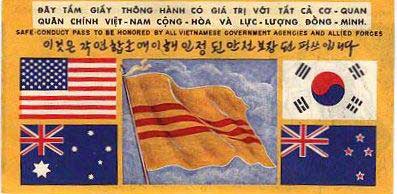
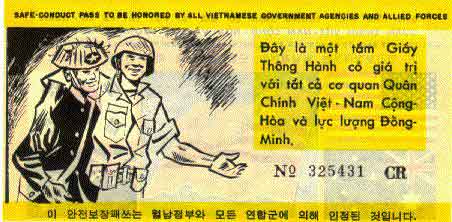
One of several versions of safe conduct passes that show a large flag of
the Republic of Vietnam at center on the front and, in the earlier versions, smaller flags
of allied nations participating in the war. The first was the five-flag pass, showing
flags of the United States, South Korea, Australia, and New Zealand, in addition to the
flag of Vietnam. This leaflet and its variants were produced before 1967. In 1967, a
seven-flag version was introduced, showing the additional flags of Thailand and the
Philippines.
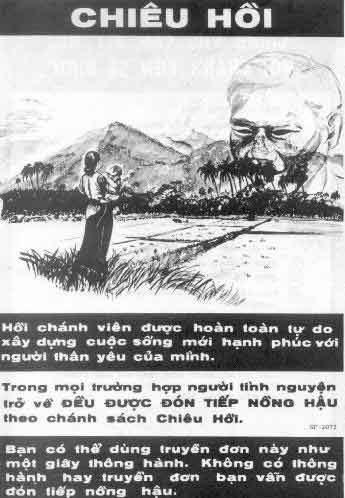
SP-2079
Leaflet # SP-2079 encouraged the distant soldier to surrender and return
to his wife, child and country. A translation of the text is: "Chieu Hoi. Returnees
are completely free to build their new lives, and enjoy hapiness with their loved
ones. Under all circumstances, those who voluntarily come back are WARMLY RECIEVED under
the Chieu Hoi Program. You may use this leaflet as a safe conduct pass. Even without a
safe conduct pass or leaflet, you are still warmly welcomed."
Fear of Death
 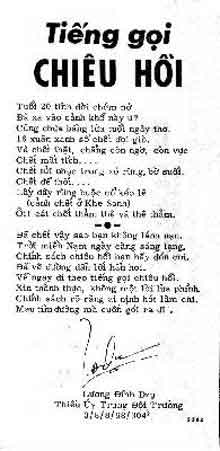
2563
USPAO leaflet 2563 depicts a large Chieu Hoi symbol on one side. The
other side is all text, "The Chieu Hoi Call. At the age of 20, you have lived a life
of hardship. But it is no match for the suffering of the innocent. The young are being
thrown into death. These deaths are certain and without a doubt. They die with their
bodies shattered and mutilated. They die shamefully in the jungle and along river banks.
They die and their decomposed bodies are hauled away by the neck with a rattan rope (the
dead at Khe Sahn). Oh, what tragic deaths. Why don't you flee to the south where life is
brighter every day? Learn about the Chieu Hoi program which will show you how to defect.
Come back in response to the Chieu Hoi call. These are my sincere words. The program is
clear. Nobody can fool you. Hurry and pack up and leave your ranks.
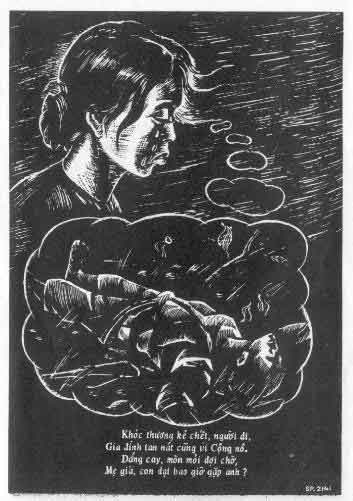
SP-2141
Leaflet # SP-2141 depicts a mother crying over the image of her dead son,
killed while fighting. The leaflet is designed to encourage enemy soldiers to rally to the
government side before being killed in battle. The text on the front of the leaflet is:
"We cry for the dead
We are bitter because of the Communists
have destroyed our families.
When will mothers and chjildren be reunited?"
The back of the leaflet lists what rewards a returnee (rallier) can
expect. The translation of the back of the leaflets is:
"Returnees Will Receive the following Rewards"
1. Be treated well.
2. Retain all privileges
3. Health care at the "returning center".
4. Be re-united with their family.
5. $30 (piasters) for each returnee; wife and grown children will each get 15 (piasters)
per month.
6. $200 (piasters) per month for errands. $15 (piasters) for each member of the family who
stays at the government center.
7. Reward for turning in your weapons $500 to $7800 (piasters).
8. Two pairs of shirts and pants or $1000 (piasters).
9. Returning home expenses of $1000 (piasters)
10. Help getting a job.
11. Returnees who wish to re-settle in the "Open Arms" hamlet will receive
cement, roofing in iron sheets, $10,000 (piasters) for home building and $2000 (piasters)
for furniture, plus a six-month supply of rice."
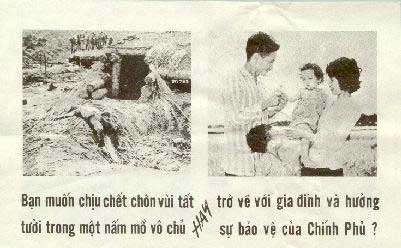
SP-782
Leaflet SP-852 has two photos. The photo on the left shows a VC bunker and
a dead VC. The photo on the right shows a VC rallier being reunited with his family. The
text on the leaflet is: "Do you want to die andd be buried in an unmarked grave or
come back to your family and enjoy the government's protection?" The reverse of the
leaflet has the same two photos and reads: "It is your choice, either this or
that."
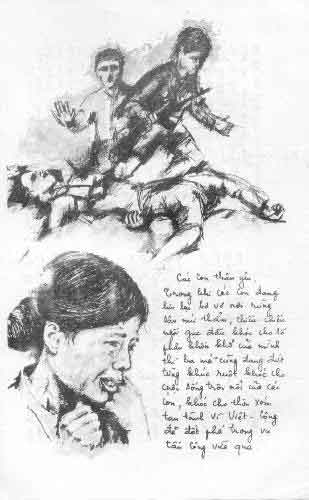
10-157-68
Leaflet SP-10-157-68 is a letter written from a mother to her beloved sons
who are members of the Viet Cong. She expresses her sorrow and worries for the lives and
future of her sons. Therefore, she tells them to go home through the government open arms
program.
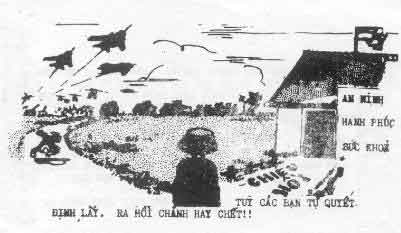
Uncoded Leaflet
This uncoded leaflet depicts a VC choosing a path, one leading to Chieu
Hoi Program and a safe and secure home, the other to war and certain death.
Money for Weapons
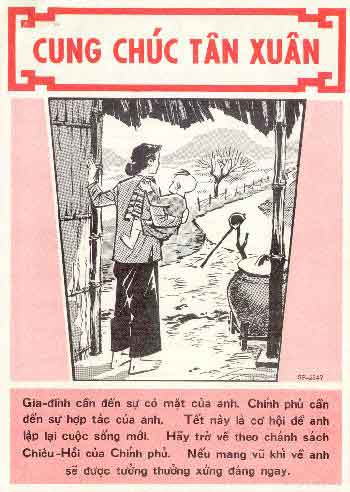
SP-2247
Leaflet # SP-2247 was developed in October 1967. The designation of the
leaflet is "Your Family Needs You". The translation for the leaflet is:
"Happy New Year, Your family needs you. Your government needs your cooperation,
Tet is the time for you to start a new life. Return to your family through the Chieu Hoi
Program of the Government of Vietnam (GNV). Rewards will be promptly paid for weapons you
return." The back side of the leaflet gives rates of rewards for weapons brought back
by returnees.
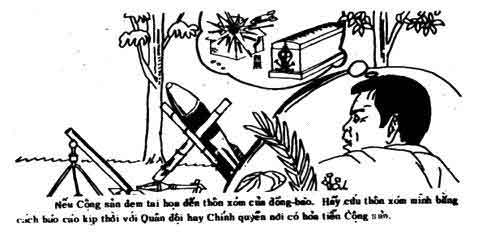
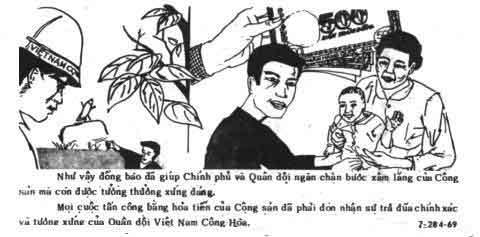
7-284-69
Leaflet 7-284-69 depicts a VC looking at a rocket placement. The text reads: "You
can not only help to stop the Communist invasion, you can also get rewarded by the
government. Any rocket attacks by the communists will be appropriately responded in kind
by the Government of Vietnam." The back of the leaflet states: "The Communists
could bring disaster to your village. Please save your village by quickly contacting your
local government or the military and showing them where you see rockets or mortars."
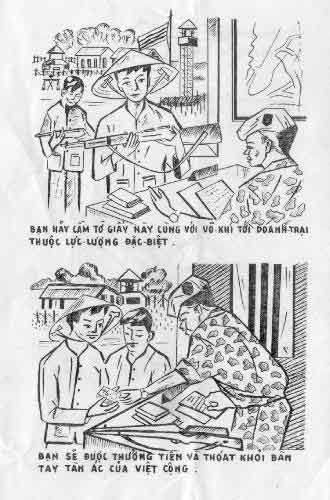
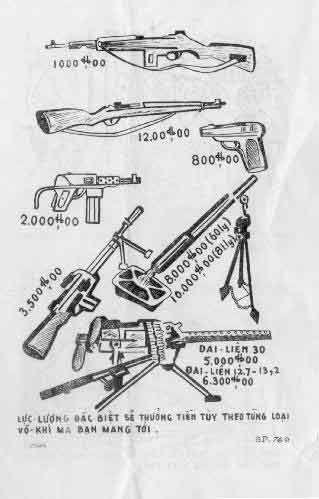
SP-769
Early in the war JUSPAO prepared leaflet SP-769. The "SP" indicated
"Special Project" and was proof to the Viet Cong that the leaflet was American.
Since it was desired that the people believe that these leaflets were coming from their
own government, the "SP" was soon removed from the code. This leaflet is an
excellent product and depicts two scenes on the front. In the first, two Vietnamese
civilians surrender rifles to an ARVN soldier. In the second, they are handed banknotes
for those weapons.
The back illustrates various weapons and lists the current prices that the government
will pay for them Some of the prices are; pistol $800VN, grease gun $2,000, mortar $8,000
to 10,000 (depending on size), and $5,000 to 6,300 for a heavy machinegun (depending on
caliber).

2808

{Translation of above leaflet}
|
TO ALL LOYAL VIET CONG.
The government of the Republic of Viet Nam will reward and assist you if you come back
|
*24 Piasters for food/rice every day
*24 Piasters every day for your wife
*12 Piasters every day for each of your children
*Will also include other (undisclosed) considerations
|
For all of the WEAPONS that you bring back, there is a reward according to each type.
|
800 Piasters for a pistol
1000 Piasters for an AK-47 or M-1 Girrand
1200 Piasters for an SKS 7.62 semi/automatic carbine
2000 Piasters for an M-3 "Grease Gun"
3500 Piasters for an RPD light machine gun
5000 Piasters for a 30 caliber medium machine gun
6300 Piasters for a 51 caliber heavey machine gun
|
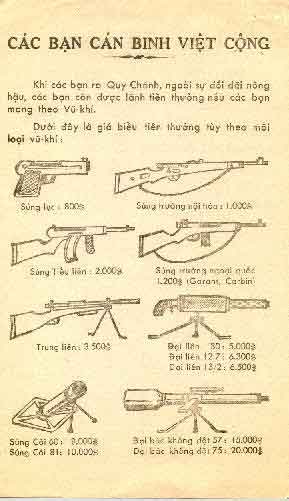
Money for Guns Leaflet
Another leaflet produced by the Government of Vietnam depicted the same items
and prices, but added a recoilless rifle listed from $15,000-20,000 (depending on size).
Return Home to Celebrate Tet New Year
One large series of JUSPAO leaflets (2913-2917) pictures various scenes of Tet New
Year's celebration. The leaflets are known in black and white on paper and in full color
on cardboard.
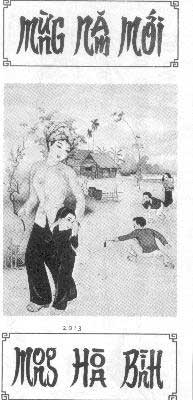
2913 Front
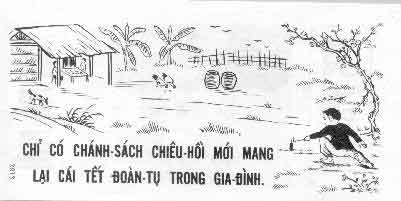
2913 Back
Leaflet 2913 shows a smiling wife holding a young girl while children light fireworks.
The text is "Happy New Year, hoping for peace." The back shows a single child
lighting a firecracker in a country scene. the text is "Only through the Chieu Hoi
policy will you bring unity to your family. There are four more almost identical leaflets
in this series ending with 2917.
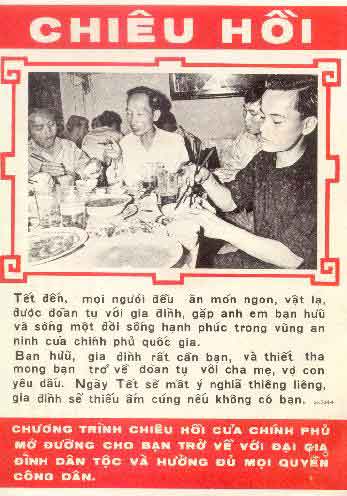
SP-2244 - Back
Leaflet # SP-2244 is another leaflet emphasizing that if the rallier takes
advantage of the Chieu Hoi program he could enjoy Tet with his family and friends. The
translation for this leaflet is: "Your family will be very sad if you are not home
for the Tet Season. we urge you to return and enjoy Tet and a Happy New Year with your
family. The newly elected Government will welsome you through its Chieu Hoi Program."
The back of the leaflet text is: The Hoi Chanh shown above are enjoying a Tet meal at a
Chieu Hoi Center. As Tet is coming everybody wants to eat good food, to be reunited with
the family, friends, and live a happy life in a secure are of the GVN. Your family needs
you and sincerely hopes that you will return to your parents and wife and children. Tet
will lack its meaning and your family will be sad if you are not at home. The Chieu Hoi
Program of the Government offers you a way back to the Great Nation's Family and to enjoy
full citzenship."
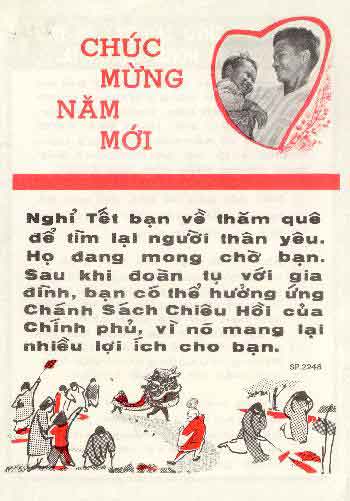
SP-2248
Leaflet # SP-2248 is another Tet leaflet. The leaflet text on the front
is: "New Years Greetings. On Tet Holiday, you will return to your home town (or
village) to look for your loved ones. They are waiting for you. After reuniting with your
family you can respond to the Chieu Hoi Policy of the GVN because it brings you many
benefits." The back side of the leaflet outlines the steps the rallier should take to
return. The text on the back is: "Follow These Instructions to return To The National
Cause. You may report to any GVN official at any GVN outpost. Or, you may come to GVN or
Allied soldiers: they will readily welcome you. In any case, follow these instructions for
security reasons:
1. Hide your weapons. Later you can lead RVNAF soldiers to the weapons and
recieve your reward.
2. When reporting to any unit or official whom you can expect to be armed,
report only in the daytime. To show your goodwill, you may display a safe conduct pass or
any other leaflet if you have one. Even if you do not have a leaflet. you can still rally.
3. When you come to report, all you have to do is help the GVN and allied
troops understand that you intend to return to the National Cause."
Loss of Faith/Disillusionment in the Communist Government
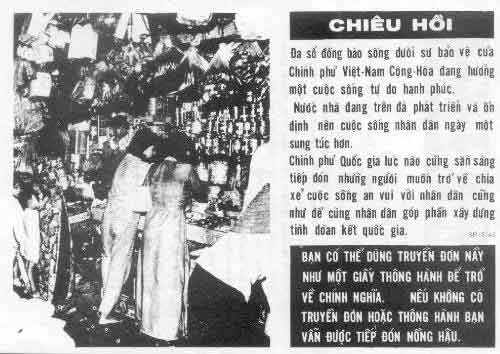
SP-2145
Leaflet # SP-2145 poses the question to the Viet Cong: "If the
Government and life in South Vietnam are so bad then why is the economy flourishing in
South Vietnam? Why do our stores and shops overflow with goods, while in the North many
shortages of items exist?" The communist Cadre preached to the Viet Cong that the
general population in the South would rise up and support them as they were unhappy and
living conditions intolerable in the South. The purpose of this leaflet was to get the
Viet Cong to wonder if this is true, what other lies had he been told and perhaps it would
be better for him to defect.
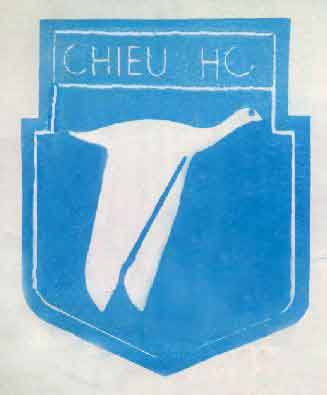
6-513-69
Leaflet 6-513-69 challenges the VC leadership. The front of the leaflet
has a blue Chieu Hoi symbol. The back of the leaflet is all text: "Attention VC
Soldiers of SH-3 1. Your NVA leaders don't keep their words to you. They don't heed the
fact that you lack weapons, ammunition, and food. They don't consider supplying
replacements for the slain ones. They care soley for themselves. All they think about is
to exploit your blood and bone as much as possible. Why do you hesitate? Under the
circumstances of shortages, the grim reaper will certainly soon come to you. decide to
rally to the GVN immediately, so that you can live in peace and happiness."
Your Family Needs You - Reunite with Loved One
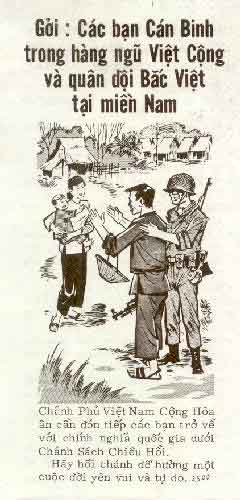
SP-2500
Leaflet # 2500 shows a happy VC returning to his wife and child while a
smiling ARVN looks on. It is addressed to: "Soldiers and Cadre of the Viet Cong and
North Vietnamese Army in South Vietnam." It reads: "The government of the
Republic welcomes returnees from your ranks under the Chieu Hoi program. Return and you
will enjoy a life of peace and freedom." The back of the leaflet outlines the rewards
a rallier can expect (e.g. good treatment, medical care, $200 (piasters) a day spending
money, $30 (piasters) a day for food, $1200 (Piasters) for clothing, etc.).
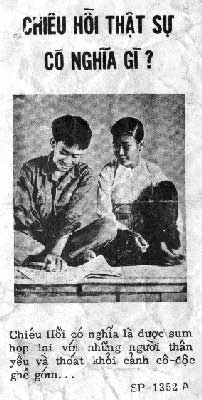
SP-1252A - Front
Leaflet SP-1252A was developed in March 1966. The text on the front of the
leaflet reads: "What does Chieu Hoi Really Mean? Chieu Hoi means being reunited with
your loved ones. It means escape from a terrible lonliness."
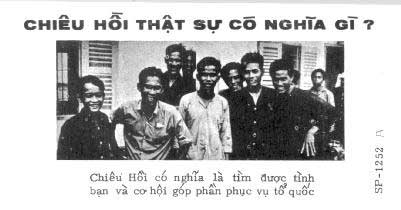
SP-1252A - Back
The reverse of leaflet SP-1252A again asks the question: "What does
Chieu Hoi Really Mean?" The leaflet further reads: "Chieu Hoi means friendships
and a chance to serve the fatherland."
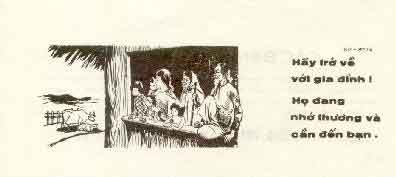
>SP-927A
Leaflet SP-927A shows a family looking out for their missing father, son,
or husband. The Front of the leaflet reads: "Return to your family! They miss you and
need you." The reverse of the leaflet is all text and reads "COMPATRIOTS - COME
HOME! Your family needs you. They fear for your health and welfare. They know you will die
if you do not heed their plea. The Government also wants you to come home. Contact the
nearest GVN soldiers or officials. You will be well treated, and both you and your family
will be helped as soon as you return to the Just Cause. DON'T DELAY. COME HOME!"
Support the GVN
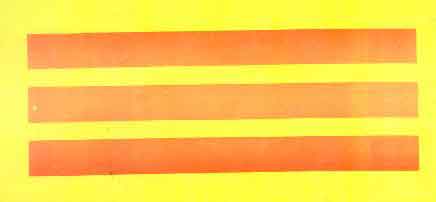
6-1051-69
The front of leaflet 6-1051-69 is an image of the flag of the government
of South Vietnam. The back of the leaflet is a government appeal with the text reading:
"The GVN today has truly grown up in every respect. In free SouthVietnam, every
citizen has the right to vote and elect his representative in the Government. Before, the
ARVN forces were not sufficient in men and equipment. Today they have grown up in combat
ability as well as experience as proved by the victories throughout the 4 Corps Tactical
Zones. The GVN, backed by the Army and the positive support of the whole people, will
definitely achieve the final victory in the protecting and holding aloft the flag of Just
Cause. To Support the Government is to help yourself ."
Personal Pleas from Hoi Chanh (former VC who had rallied
The way that some of these leaflets came to be written is a story in itself. The Chieu
Hoi Newsletter, Chieu Hoi Division, Office of Civil Operations, United States Mission
to Vietnam, 27 April 1967, explains:
"Chieu Hoi and PSYOP advisors at the Rach Gia Chieu Hoi Center in
Kien Giang Province came up with a new twist to an incentive program for Chieu Hoi
ralliers. Every day they would give the Hoi Chanh at the center an opportunity to write
their personal testimonies about rallying. Each was furnished with a pen and blank JUSPAO
stationary paper.
The rallier was asked to write a brief message on one side of the paper explaining that
he had rallied and that the Chieu Hoi Program was as stated by the GVN. Each written
leaflet was then placed in a raffle box and a prize was given to the lucky Hoi Chanh at a
drawing held at the end of each month. This action encouraged each rallier to write a
maximum number of leaflets. Some wrote as many as 400 during their stay. The average
number was 65.
The leaflets, several thousand each month, were re-sorted into individual stacks and
marked with the exact location of the man's last home. This location was then converted
into the grid coordinates of a pilot's map of the area. Each stack was then wrapped and
bound with a rubber band to which a six-foot drawstring was attached. The addressed
packages were then taken to an airstrip from which three Forward Area Controllers (FAC)
pilots operated. The FAC's used the grid coordinates like a zip code and dropped the
leaflets precisely on target."
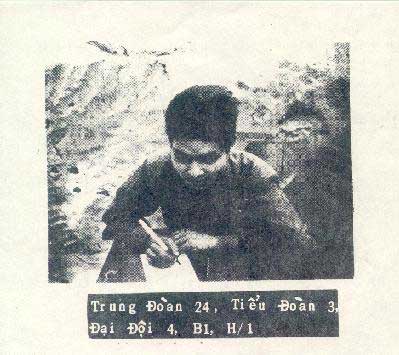
8(2)-3-40-68
Leaflet # 8(2)-3-40-68 has a photo of a VC defector writing a letter to
his former comrades. The back of the leaflet shows the letter which reads in part:
"My comrades, save yourselves! The GVN will treat you kindly, as a mother would a
son. Soldiers of H3 (his unit)and soldiers of other units, rally now, Do not delay!"
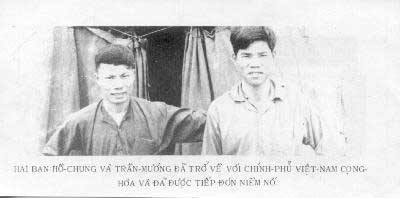
7-494-68
Leaflet # 7-494-68 shows another photo of two ralliers, on the back of the
leaflet is a handwritten letter to their comrades encouraging them to take advantage of
the Chieu Hoi Program and join them.
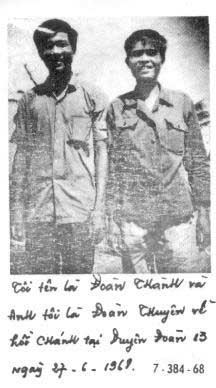
7-384-68
Leaflet #7-384-68 is another photo of two ralliers with again
a personal plea to their comrades to Chieu Hoi and join them.
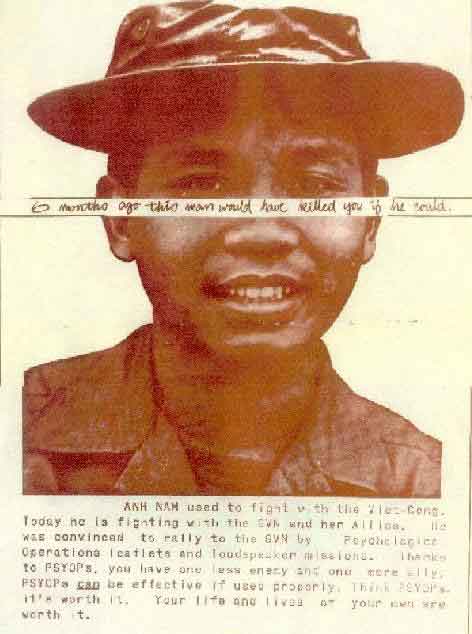
"6 months ago this man would have killed you...."
In order to emphasize the importance of the Chieu Hoi Program and to
garner support of the use of PSYOP among US Forces, the 6th PSYOP Battalion published the
above poster which reads: "6 months ago this man would have killed you if he
could." The text at the bottom of the poster goes on to state: "Anh Nam used to
fight with the Viet Cong. Today he is fighting with the GVN and her Allies. He was
convinced to rally to the GVN by Psychological Operations leaflets and loudspeaker
missions. Thanks to PSYOPs, you have one less enemy and one more ally. PSYOPs can be
effective if used properly. Think PSYOPs. It's worth it. Your life and the lives of
your men are worth it".
This concludes our look at the Chieu Hoi program. It was clearly successful in getting
large numbers of Viet Cong to rally to the government. On the other hand, it also seems
clear that the defectors were mainly low level soldiers and porters, and few officers or
dedicated well-indoctrinated troops came over. We remind the reader that we have just
touched on the subject. Readers who wish to discuss this operation in more detail are
encouraged to write the author at Bertf@webtv.net
|
